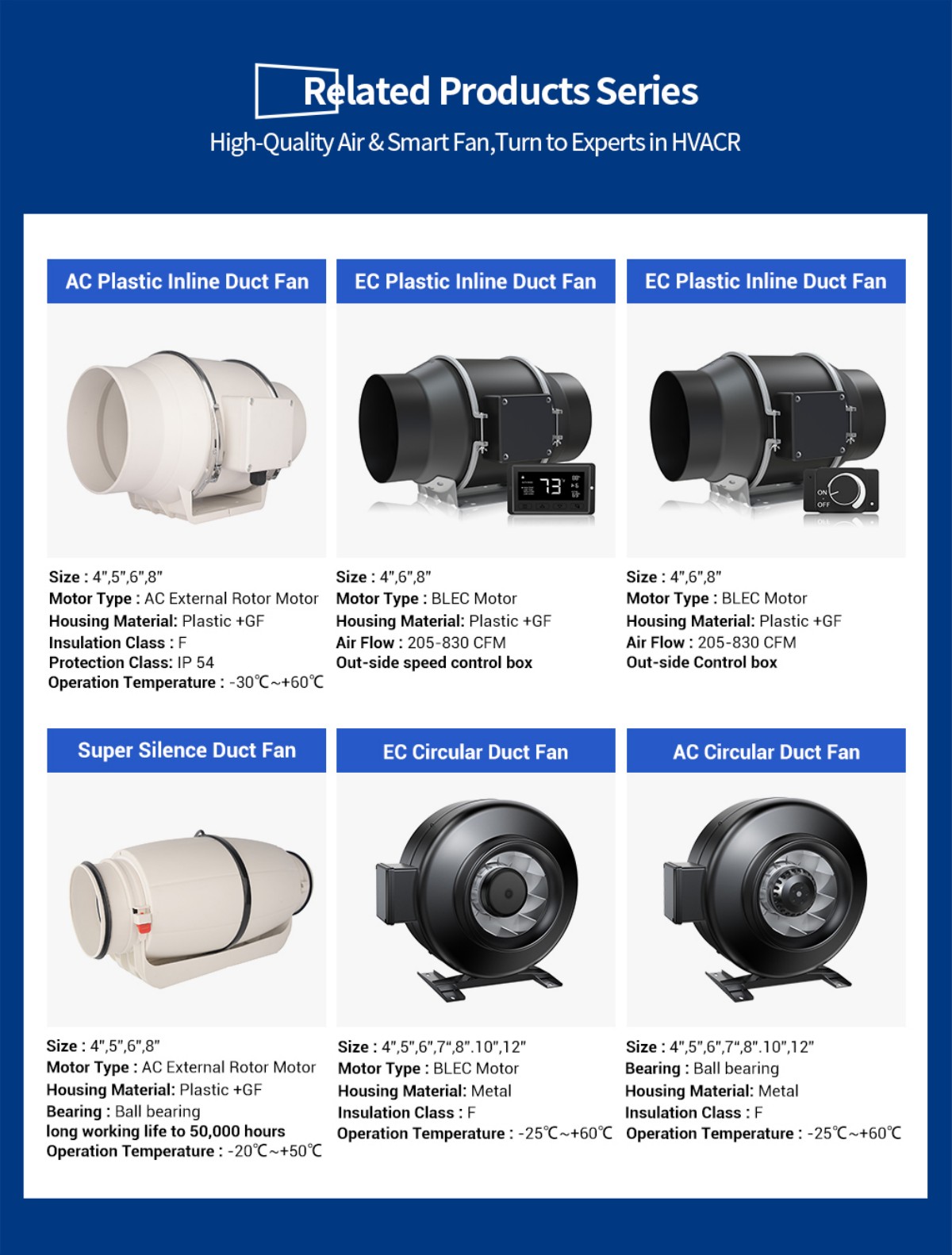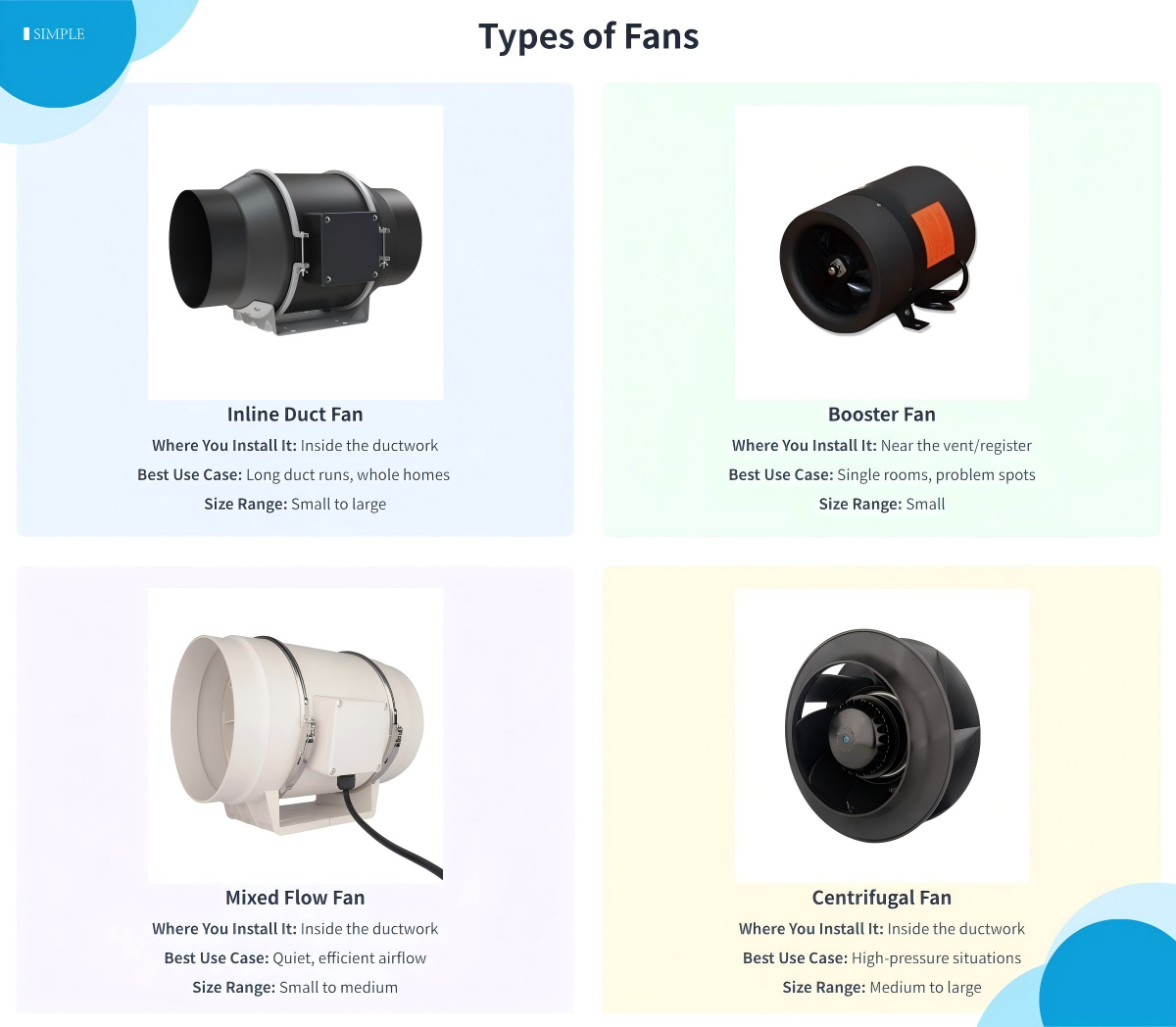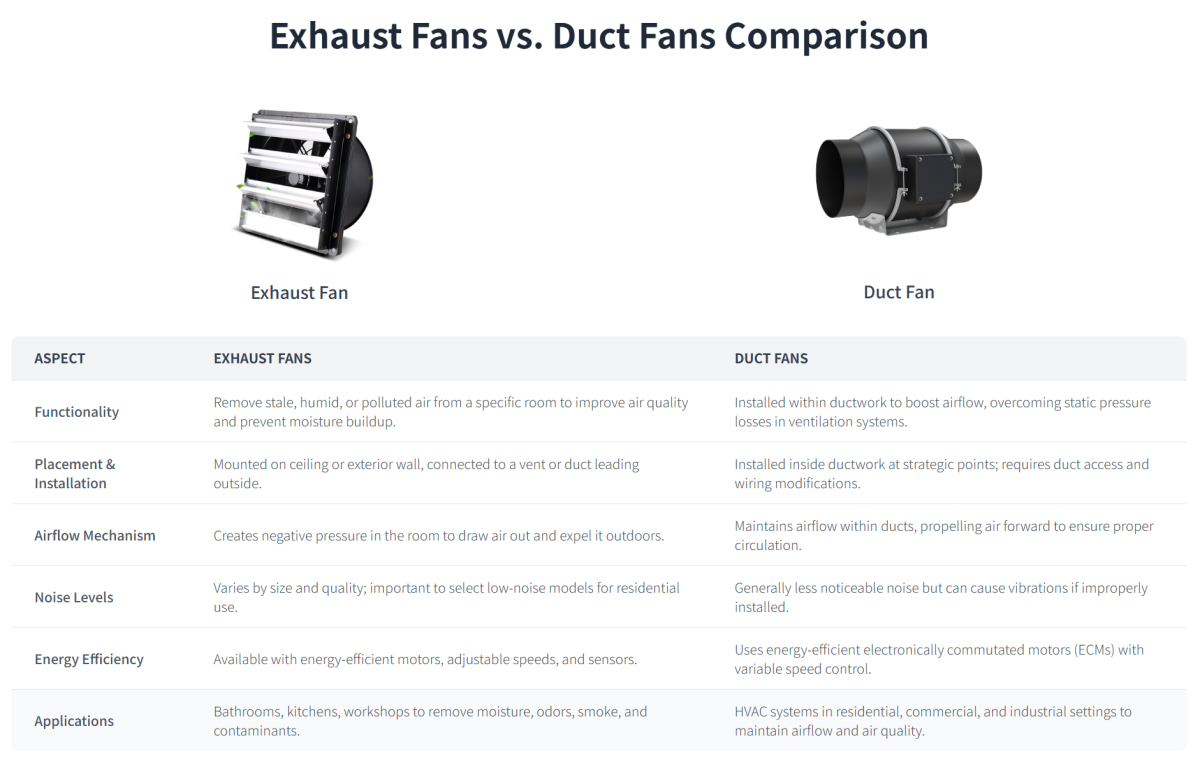What Is a Duct Fan and How Does It Work

A duct fan is a machine that helps move air in your home. It pushes air through the ducts in your house. You use a duct fan to make air flow better. It helps rooms that feel stuffy or have hot and cold spots. When you turn on the duct fan, its blades spin fast. The spinning blades push air through the ducts. This helps your heating or cooling system work better. Studies show a duct fan can boost airflow by up to 46%. It can also help lower energy use by as much as 60%. If you ask "how does it work," the answer is easy. The fan makes air move all the time. This makes the air inside your home fresher and more comfortable.
Key Takeaways
Duct fans push air through your home's ducts. This helps air move better and makes every room more comfortable. Inline duct fans are good for long ducts. Booster fans help fix air problems in one room. Pick the right fan blade shape for best results. Put the fan 6 to 10 feet from the vent. This helps air move better and keeps things quieter. Duct fans help save energy. They make your heating and cooling system work better. They also help keep the air inside cleaner. Use duct fans to keep room temperatures even. Use exhaust fans only to get rid of old or wet air in certain rooms.
Duct Fan Types

When you look at duct fans, you will find several main types. Each type works best for different needs in your home. You can choose the right one by learning how each type helps move air through your ductwork.
Inline Duct Fan
An inline duct fan sits inside the duct itself. You place it right in the middle of the duct run, so air flows straight through the fan. Inline fans have a long, round shape. This shape fits well with most ductwork. You often use duct inline fans to boost airflow in long stretches of duct or to help air reach rooms far from your main system.
Inline fans come in many sizes. Some are small for single rooms. Others are large for bigger spaces. You can use inline fans with heating, cooling, or ventilation systems. Many people pick inline fans because they work quietly and do not take up much space.
You will find that duct geometry can change how well an inline duct fan works. For example, a lip-extended duct shape can give you more thrust and better airflow. A lip-shaped duct may not work as well because it creates more circulating airflow, which lowers the fan’s power. The shape of the duct around the fan matters almost as much as the fan itself.
You can also find different types of inline fans. Some use mixed flow technology, which combines the best parts of axial and centrifugal fans. Mixed flow inline fans move air quickly and quietly. Centrifugal inline fans use spinning blades to push air out to the sides, which helps in high-pressure situations.
Tip: If you want to improve airflow in a room far from your furnace or AC, try using an inline duct fan about 6 to 10 feet from the vent.
Booster Fan
A booster fan helps when you have one room that never feels right. Maybe it is always too hot or too cold. You install a booster fan near the end of the duct, close to the vent. This fan gives an extra push to the air, so it reaches the room better.
Booster fans are smaller than inline fans. You can add them to existing ducts without much trouble. Many booster fans turn on and off with your heating or cooling system. Some models even have sensors that start the fan when they sense air moving.
You might see booster fans called register fans. These fit right into the vent opening. They work best for single rooms that need a little more airflow.
Other Variations
You will also find other types of duct fans. Some use electric motors, while others use mechanical systems. Recent market reports show that electric-powered duct fans are becoming more popular. People like them because they save energy and cost less to run. Technology keeps improving, so you can expect duct fans to get even better in the future.
Here is a quick comparison of the main types:

Type | Where You Install It | Best Use Case | Size Range |
|---|---|---|---|
Inline Duct Fan | Inside the ductwork | Long duct runs, whole homes | Small to large |
Booster Fan | Near the vent/register | Single rooms, problem spots | Small |
Mixed Flow Fan | Inside the ductwork | Quiet, efficient airflow | Small to medium |
Centrifugal Fan | Inside the ductwork | High-pressure situations | Medium to large |
You can see that each duct fan type has its own strengths. Inline fans work well for big jobs. Booster fans help with small fixes. Mixed flow and centrifugal fans give you more options for special needs.
How Duct Fans Work
Airflow and Blades
A duct fan moves air by spinning its blades inside the duct. When you turn on the fan, the blades rotate quickly. This spinning action pushes air forward and pulls air from behind. The shape and angle of the blades matter a lot. If the blades have the right pitch, they create more lift and thrust with each spin. This means you get stronger airflow without using too much energy.
Studies show that the number of blades and their shape also affect how well the fan works. Three-blade fans often move air faster, while five-blade fans run more quietly and give steady airflow. The material of the blades can change how much air the fan moves. Lighter, stronger materials help the blades spin faster and last longer.
Engineers use special tests and computer models to check how well different blade designs work. For example, adding ducts to the blades can increase the energy of the air moving over them. This helps the fan keep the air attached to the blade surface, which boosts airflow and makes the fan more efficient. If you use an inline duct fan with curved or airfoil-shaped blades, you can get smoother airflow and less noise.
Tip: Choosing a duct fan with the right blade design can improve airflow efficiency and lower your energy bills.
Placement in Ducts
Where you put your duct fan makes a big difference. If you place the fan too close to the vent, it might make more noise and not move air as well. Experts recommend installing the fan about 6 to 10 feet from the register or vent. This spot helps the fan push air evenly through the duct and into the room.
You should also think about the size and shape of your ducts. Smaller ducts need more power from the fan to move the same amount of air. If your ducts have leaks, the fan has to work harder, which wastes energy. Keeping your ducts sealed and smooth helps the fan do its job better.
Some homes use a long stretch of ductwork to reach far rooms. In these cases, an inline duct fan can help boost airflow to those areas. If you have a room that always feels stuffy, adding a fan in the right spot can make a big difference.
Here is a quick checklist for placing your duct fan:
Measure the distance from the vent to the main duct line.
Check for any leaks or gaps in the ductwork.
Place the fan 6 to 10 feet from the register for best results.
Make sure the fan fits snugly inside the duct.
Test the airflow after installation to see if the room feels more comfortable.
Note: Well-placed duct fans not only improve airflow but also help your heating and cooling system use less energy.
Home Ventilation Benefits
Improved Airflow
You want each room to feel nice and comfortable. Duct fans help by moving air better in your house. When you put in a duct fan, it pulls air through the ducts more easily. This helps get rid of hot or cold spots. It also makes the temperature in every room more even. Inline duct fans go inside the ductwork and help your HVAC system move air farther. You get better air spread, so your whole-house ventilation works right. Many people see that rooms far from the main system finally get enough air. This better airflow makes your home feel nicer.
Tip: If a room always feels stuffy, a duct fan can help by moving more air where you need it.
Energy Efficiency
Saving energy is good for your money and the planet. Duct fans made for energy savings use less power than old fans. Studies show that mechanical ventilation with small fans can use up to 40% less energy than older systems. These fans lower the pressure in your ducts, so your main fan does not work as hard. Some systems use smart controls to change fan speed, which can save another 20% energy when you do not need as much air. Picking an energy-saving duct fan helps lower your bills and is better for the earth.
Comfort and Air Quality
Good ventilation does more than just move air around. It also keeps your home healthy. Using a duct fan helps remove dust, water, and bad stuff in the air. Research from the Breathe Easy study shows homes with duct fans have less indoor pollution. Families with asthma felt better after putting in these fans. Other studies in schools and kitchens show duct fans lower bad particles and control wetness in the air. You also stop mold and bad smells by keeping air moving. With better ventilation, your home is safer and more comfortable for everyone.
Benefit | How Duct Fans Help |
|---|---|
Improved Airflow | Balances temperature in all rooms |
Energy Efficiency | Cuts energy use and lowers bills |
Comfort & Air Quality | Reduces pollutants and humidity |
Duct Fan vs. Exhaust Fan
Key Differences
You may wonder how a duct fan is different from an exhaust fan. Both move air, but they do not work the same way. They also have different jobs in your home. The table below shows how they are not alike:

Aspect | Exhaust Fans | Duct Fans |
|---|---|---|
Functionality | Remove stale, humid, or polluted air from a specific room to improve air quality and prevent moisture buildup. | Installed within ductwork to boost airflow, overcoming static pressure losses in ventilation systems. |
Placement & Installation | Mounted on ceiling or exterior wall, connected to a vent or duct leading outside. | Installed inside ductwork at strategic points; requires duct access and wiring modifications. |
Airflow Mechanism | Creates negative pressure in the room to draw air out and expel it outdoors. | Maintains airflow within ducts, propelling air forward to ensure proper circulation. |
Noise Levels | Varies by size and quality; important to select low-noise models for residential use. | Generally less noticeable noise but can cause vibrations if improperly installed. |
Energy Efficiency | Available with energy-efficient motors, adjustable speeds, and sensors. | Uses energy-efficient electronically commutated motors (ECMs) with variable speed control. |
Applications | Bathrooms, kitchens, workshops to remove moisture, odors, smoke, and contaminants. | HVAC systems in residential, commercial, and industrial settings to maintain airflow and air quality. |
An exhaust fan pulls air out of a room, like a bathroom or kitchen. It sends the air outside. This helps get rid of smells, steam, and dirty air. A duct fan sits inside your ducts. It pushes air through the ducts to help air move better in your house. Duct fans help your heating and cooling system reach every room.
Duct fans and exhaust fans are measured in different ways. Duct fans use total pressure and total efficiency to show how well they move air. Exhaust fans use static pressure and static efficiency because they often send air straight outside.
Note: Duct fans make air move faster and add pressure. Exhaust fans focus on pulling air out using static pressure.
When to Use Each
You should pick a duct fan or an exhaust fan based on what you need.
Use an exhaust fan if you want to take out wet or dirty air from one room. Bathrooms need exhaust fans to get rid of steam and stop mold. Kitchens use exhaust fans to clear out smoke and cooking smells.
Pick a duct fan if you want to help your HVAC system move air better. Duct fans are good for rooms that do not get enough air or when your ducts are long and air has trouble reaching the end. A duct fan can help your heating or cooling system work better in every room.

Here are some tips to help you choose:
If you want to follow building rules for bathrooms, put in an exhaust fan with the right airflow rating.
For kitchens, make sure your exhaust fan covers your whole cooktop and meets the airflow rate.
If your home has rooms with different temperatures, a duct fan can help even things out.
Always check that your fan meets ENERGY STAR rules for saving energy and making less noise.
Tip: Pick fans with Home Ventilating Institute (HVI) certification. This helps you get the right airflow and sound for your space.
Installation Tips
Sizing and Fit
Getting the right size duct fan is important for good airflow. You need to match the fan to your room and duct size. Start by measuring the length, width, and height of your room. Multiply these numbers to find the total cubic feet. This tells you how much air you need to move. Next, decide how often you want to exchange the air in the room. Many experts suggest changing all the air every 1 to 3 minutes. Divide the room’s cubic feet by the number of minutes to get the cubic feet per minute (CFM) rating you need.
You may need to adjust this number. If your duct has bends, add 10–25% more CFM. If you use a carbon filter or have high temperatures, add another 25%. This helps the fan work well even with extra resistance. Technical manuals, like those from AECOsim Building Designer, show that you should also check duct width, height, and length. These guides use airflow rates, pressure loss, and fitting loss values to help you pick the right fan. Using these numbers makes sure your fan fits and works well in your system.
Tip: Always check the manufacturer’s chart for CFM ratings and duct sizes before you buy a fan.
Basic Steps
You can install a duct fan by following a few clear steps. Here is a simple guide:
Clean your ductwork and cut the duct to fit the fan’s size.
Mount the fan inside the duct. Make sure it lines up straight and sits firmly.
Connect the ducts to the fan. Use foil tape or zip ties to seal any gaps and stop air leaks.
Turn off the power. Wire the fan safely, following the instructions.
Adjust dampers and vents to balance the airflow in your home.
After you finish, test the fan. Run it at full power and check for leaks by feeling for air or using a smoke test. Make sure the air flows in the right direction. You can fine-tune the fan speed if your system allows. This helps you get the best comfort and energy savings.
🛠️ Note: A well-installed duct fan improves airflow and keeps your home comfortable all year.
You now know that a duct fan helps move air through your home’s ducts. It boosts ventilation, keeps rooms comfortable, and supports even air distribution. You can use a duct fan when you want better airflow or need to fix hot and cold spots. Here are some key benefits:
Inline duct fans improve ventilation by reducing friction and supporting long duct runs.
They lower noise and help keep indoor air fresh.
These fans make your HVAC system work less and keep temperatures steady.
Modern designs fit easily and can connect to smart controls for better comfort.
A duct fan is a smart choice when you want reliable ventilation and a more comfortable home.
FAQ
What size duct fan do you need for your room?
You need to measure your room’s length, width, and height. Multiply these numbers to get cubic feet. Divide by the number of minutes you want for air exchange. This gives you the CFM rating you need for your duct fan.
Can you install a duct fan yourself?
Yes, you can install a duct fan if you follow the instructions. Make sure you turn off the power first. Use the right tools and check for air leaks after you finish. If you feel unsure, ask a professional for help.
How often should you clean your duct fan?
You should clean your duct fan every 6 to 12 months. Dust and debris can build up and slow the fan. Regular cleaning helps your fan work better and last longer.
Tip: Use a vacuum or soft brush to remove dust from the blades.
Will a duct fan make your home noisy?
Most duct fans run quietly, especially if you install them 6 to 10 feet from the vent. Some noise may happen if the fan is too close to the register or if the duct is loose. Choose a fan with a quiet rating for best results.
See Also
Understanding Blower Fans And Their Operating Principles
Selecting The Best Cross Flow Fan For Your Needs
Key Industrial Blower Fan Innovations Manufacturers Must Follow